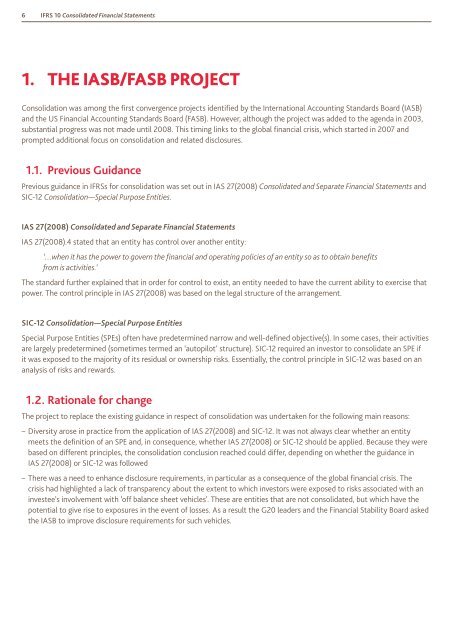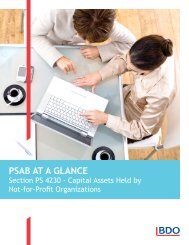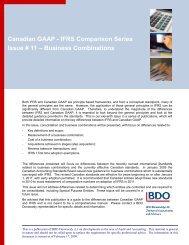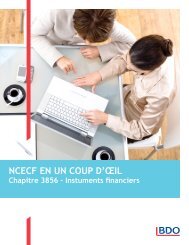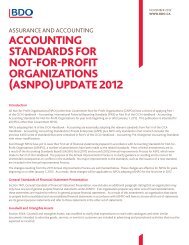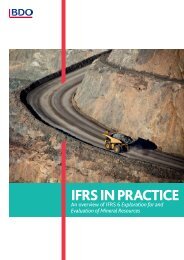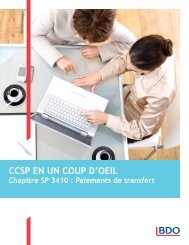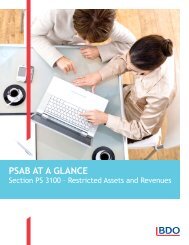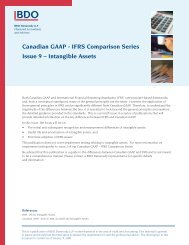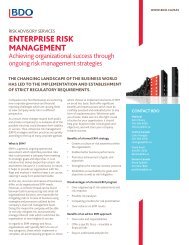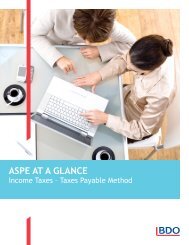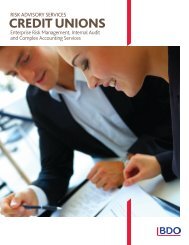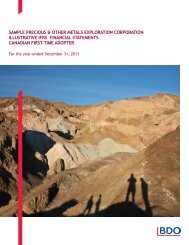Need to Know: IFRS 10 - Consolidated Financial ... - BDO Canada
Need to Know: IFRS 10 - Consolidated Financial ... - BDO Canada
Need to Know: IFRS 10 - Consolidated Financial ... - BDO Canada
- No tags were found...
Create successful ePaper yourself
Turn your PDF publications into a flip-book with our unique Google optimized e-Paper software.
6 <strong>IFRS</strong> <strong>10</strong> <strong>Consolidated</strong> <strong>Financial</strong> Statements1. The IASB/FASB projectConsolidation was among the first convergence projects identified by the International Accounting Standards Board (IASB)and the US <strong>Financial</strong> Accounting Standards Board (FASB). However, although the project was added <strong>to</strong> the agenda in 2003,substantial progress was not made until 2008. This timing links <strong>to</strong> the global financial crisis, which started in 2007 andprompted additional focus on consolidation and related disclosures.1.1. Previous GuidancePrevious guidance in <strong>IFRS</strong>s for consolidation was set out in IAS 27(2008) <strong>Consolidated</strong> and Separate <strong>Financial</strong> Statements andSIC-12 Consolidation—Special Purpose Entities.IAS 27(2008) <strong>Consolidated</strong> and Separate <strong>Financial</strong> StatementsIAS 27(2008).4 stated that an entity has control over another entity:‘…when it has the power <strong>to</strong> govern the financial and operating policies of an entity so as <strong>to</strong> obtain benefitsfrom is activities.’The standard further explained that in order for control <strong>to</strong> exist, an entity needed <strong>to</strong> have the current ability <strong>to</strong> exercise thatpower. The control principle in IAS 27(2008) was based on the legal structure of the arrangement.SIC-12 Consolidation—Special Purpose EntitiesSpecial Purpose Entities (SPEs) often have predetermined narrow and well-defined objective(s). In some cases, their activitiesare largely predetermined (sometimes termed an ‘au<strong>to</strong>pilot’ structure). SIC-12 required an inves<strong>to</strong>r <strong>to</strong> consolidate an SPE ifit was exposed <strong>to</strong> the majority of its residual or ownership risks. Essentially, the control principle in SIC-12 was based on ananalysis of risks and rewards.1.2. Rationale for changeThe project <strong>to</strong> replace the existing guidance in respect of consolidation was undertaken for the following main reasons:––Diversity arose in practice from the application of IAS 27(2008) and SIC-12. It was not always clear whether an entitymeets the definition of an SPE and, in consequence, whether IAS 27(2008) or SIC-12 should be applied. Because they werebased on different principles, the consolidation conclusion reached could differ, depending on whether the guidance inIAS 27(2008) or SIC-12 was followed– – There was a need <strong>to</strong> enhance disclosure requirements, in particular as a consequence of the global financial crisis. Thecrisis had highlighted a lack of transparency about the extent <strong>to</strong> which inves<strong>to</strong>rs were exposed <strong>to</strong> risks associated with aninvestee’s involvement with ‘off balance sheet vehicles’. These are entities that are not consolidated, but which have thepotential <strong>to</strong> give rise <strong>to</strong> exposures in the event of losses. As a result the G20 leaders and the <strong>Financial</strong> Stability Board askedthe IASB <strong>to</strong> improve disclosure requirements for such vehicles.


